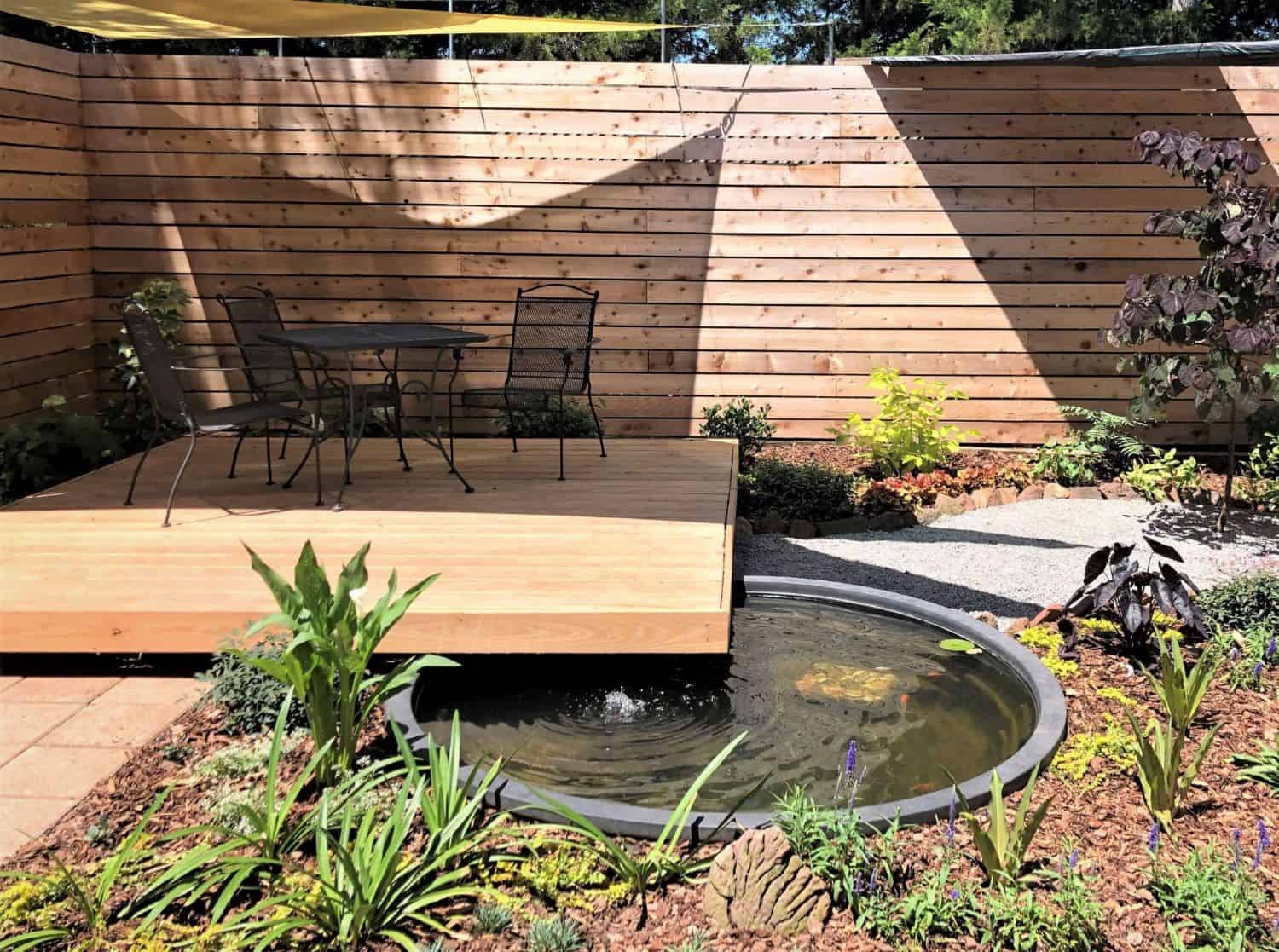
If you are wondering how to build a floating deck, you’ve come to the right place. A floating deck is an inexpensive, freestanding platform that is surprisingly easy to build. The deck floats just above the ground atop preformed concrete blocks. It is not difficult to build, and it can be installed in most lawn or garden areas.
Raising the deck off the ground allows the wood to dry out after rainstorms, helping it to last longer. The simple act of stepping up onto a platform helps establish a sense of place in the landscape.
Elevating the floating deck also accommodates unique design elements. In the project described in detail below, we built a deck that cantilevers over a water garden. The floating deck is attractive, and it creates a serene gathering spot where the landscape can be enjoyed.

How to Build a Floating Deck: Materials Needed
The tools and materials specified below are required to build a floating deck that is 10 feet by 10 feet. Adjust board lengths and the number of concrete deck blocks to build a larger or smaller deck.
Editor’s Note: At Home, Garden and Homestead, we want this How to Build a Floating Deck story to be complete. We also want to inspire you to actually build the deck. That’s why we have embedded links to many of the tools and supplies you need. Just click on the link and you will be taken to Amazon for buying information. We earn a small commission from qualified sales—at no cost to you. Thanks for supporting this website!
Tools Required
-
Shovel
-
Rake
-
Tape measure
-
48-inch level
-
Tamper
-
Circular saw
-
Steel carpenter square
-
Cordless drill and drill bits
-
Deck jig (optional)*
*If using a deck jig, be sure to purchase compatible deck screws as described below.
Building Materials
These materials can be purchased locally at a building supply center, home improvement store or a hardware/lumber store.
- 8 Landscape stakes
- String
- Landscape fabric and pins
- Gravel or aggregate base (often sold as paver base)
- 4 Ground anchors
- 4 Carriage Bolts sized to accommodate ground anchor eyelet
- 14 7-inch x 11-inch x 11-inch concrete deck blocks
- 3 1/2-inch and 2 1/2-inch deck screws
- Joists and Rim Joists: 11 Pressure-treated 2x6s (10 feet long)
- Trim Boards: 4 Pressure-treated 2x8s (12 feet long)
- 21 Pressure-treated 5/4 decking boards (10 feet long)
The Floating Deck Layout
The basic design of the floating deck uses preformed concrete deck blocks to provide a sturdy base for the deck frame, which is finished using wooden or composite decking. The block layout, adjustable for any sized deck, consists of two or more parallel lines of blocks running the length of the deck. The deck blocks hold joists, spaced 16 inches apart, that provide the main structure for the deck.
Because of the cantilevered design of our floating deck, we used a slightly different arrangement for the blocks. One row runs parallel to the back edge of the deck, set in about 12 inches from what will be the finished edge. The front row curves around the water garden, then runs parallel to the first row, again twelve inches from the edge of the deck.
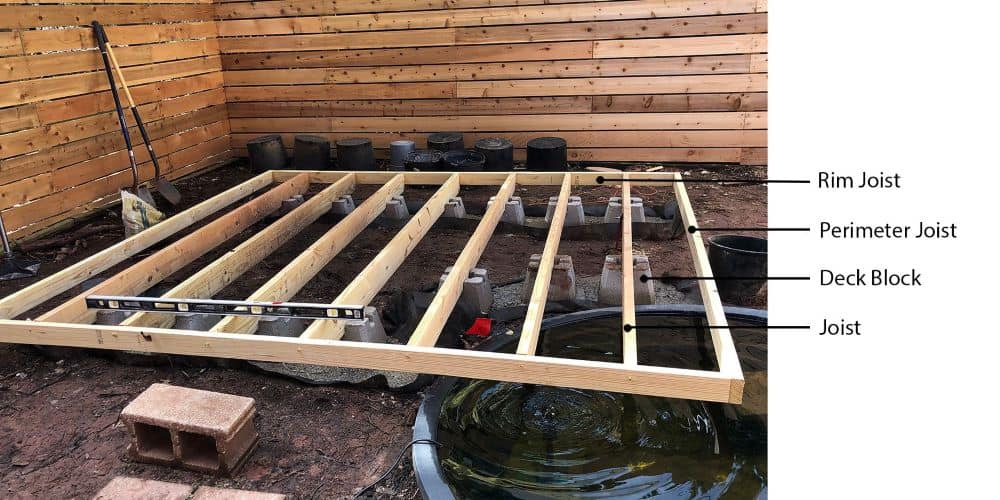
How to Build a Floating Deck, Step 1
Determine the Size of Your Floating Deck
The first step in building your floating deck is determining the location and size. Select a relatively flat area in the landscape to build your floating deck. Select a mostly level spot, but the area does not need to be perfectly level. The concrete blocks and a small amount of digging can accommodate a few inches of elevation change.
Measure the space in your yard and draw a quick sketch of the deck, with the length and width identified. Use this sketch to determine the length of boards and number of concrete deck blocks required. Larger decks will require more blocks to support longer joists.
Joists will be spaced 16-inches apart, so the width of your deck will determine how many joists and perimeter deck blocks are needed. For the perimeter of your deck, plan for a deck block every 16-inches placed in two parallel rows to support the ends of the joists. Long joists may need the additional support of an interior row of deck blocks. As a rule of thumb, space interior rows of deck blocks 4-6 feet apart.
Step 2. Check Utilities and Permits
Before you start the project, call 811 or your local “Before-You-Dig” hotline to check for underground utilities. You will also want to check with your local municipal office to see if a permit is needed.
Because a floating deck is not attached to the building or ground, a building permit is typically not required. And the low profile means you do not need to build a safety rail around the deck.
Step 3. Mark and Prepare the Building Area
Prepare the deck area by removing vegetation and raking the soil smooth. Remove soil from high areas and move it into low areas to create a level surface.
Using a tape measure, string, and landscape stakes, mark the outline of the deck. Drive two landscape stakes into the ground at each corner, about twelve inches beyond the edge of the deck. Run string between the stakes, overlapping at the corners. Check to make sure your outline is square by measuring the two diagonals, which should be equal. If the diagonal measurements are not equal, adjust the corners until your outline is squared.
How to Build a Floating Deck, Step 4: Setting the Base
Setting the blocks on a gravel base helps with the leveling process. Start by excavating a shallow trench (about four inches deep) for each row of blocks. Dig the trench 6 to 8 inches wider than the deck blocks to allow for adjustments in alignment. The trenches should run parallel to one another, about six to twelve inches in from the final edge of the deck.
Line the trenches with landscape fabric and pin the fabric in place. You can cover the entire area beneath the deck with landscape fabric if desired to help combat weeds. Fill the trenches with a few inches of aggregate (gravel) base and pack it down with a tamper.
Step 5. Set the Corner Blocks
Now you are ready to set your blocks in place. Start by setting the four corner blocks. Level the blocks using a 48-inch level set on a joist board running between two blocks at a time. Wiggle blocks that are too high deeper into the aggregate base until they are level. Add additional aggregate beneath blocks that are too low. Continue adjusting until all four corners are level with one another.
For decks with more than two rows of deck blocks, set the perimeter blocks for the interior row(s) and adjust the height until they are level with the corners. You are now ready to set the remaining blocks.
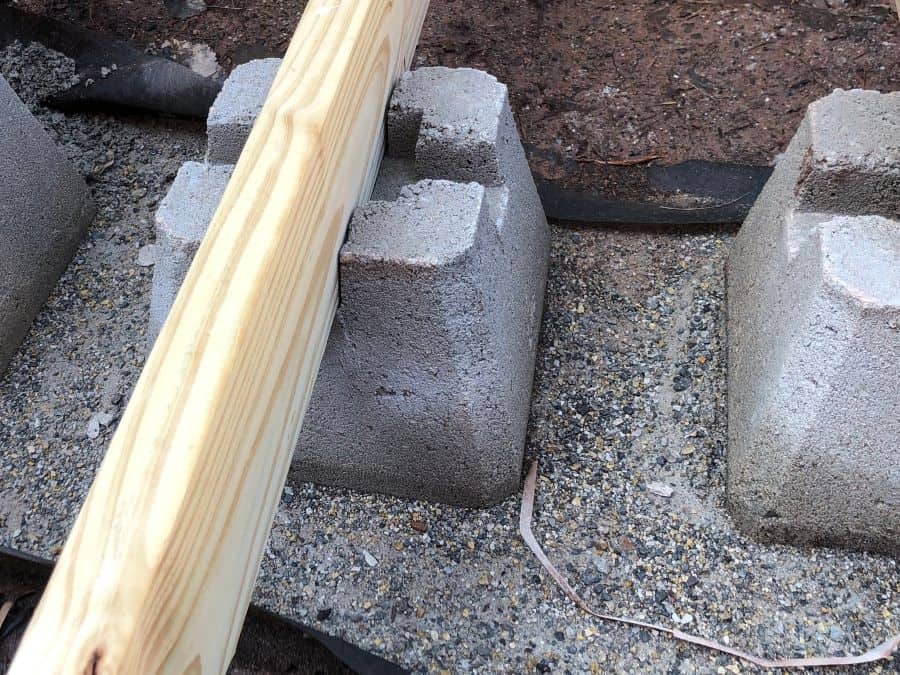
Step 6. Set the Remaining Deck Blocks
Next, place the center block in each row. Once again, use a joist board to check for level and raise or lower with aggregate as needed. Space the remaining deck blocks 16-inches apart (center to center), leveling each as you go until the entire perimeter and any interior rows are set. Individual blocks within the rows must align with each other in a grid to hold the joists.
To level the deck blocks along the curve of the water garden, we placed the straight (back) row first. Then we used these to level the blocks around the water garden.
Step 7. Framing the Floating Deck
The finished dimensions of our deck are 10 feet by 10 feet. Before setting the joists, we needed to cut them to the proper size, keeping in mind the rim joists are each 1 ½ inches wide. For our project, the joists were cut at 117 inches long (10 feet minus 3 inches to accommodate width of the two rim joists).
To ensure our deck was square, we started by setting joists on the outermost deck blocks. Then we attached the rim joists using 3 1/2-inch deck screws. Next, we finished the outer square frame of the deck by attaching the unsupported perimeter joists. NOTE: Check to make the frame is square by measuring the two diagonals, which should be equal. If the diagonal measurements are not equal, adjust the frame and remeasure. You can also use a steel carpenter square to assist in getting your corners squared.
How to Build a Floating Deck, Step 8: Set Interior Joists
Once the frame is square, you can set the remaining joists in place. Attach the rim joists to each joist using 3 1/2-inch deck screws. Double check that everything is level once the frame is in place and adjust as needed.

Step 9. Anchoring Your Floating Deck
Some municipalities require floating decks to be anchored to the ground. Installing ground anchors prevents the deck from being lifted by heavy winds.
With our cantilevered design, anchors provide additional stability. Use a shed anchor kit or a similar product, attaching the anchors to joists in multiple locations.

Step 10. Install Decking
Once the frame is complete and anchored in place, it is time to install the decking. We used pressure-treated pine decking boards for a natural appearance, but composite deck boards work equally well. Some composite materials have special fasteners, so be sure to follow the specific installation instructions for your chosen decking.
Decking boards are laid perpendicular to the joists and are attached to each joist using 2 1/2-inch deck screws. Work from one edge of the deck toward the other. Leave a small gap between each board to allow water to drain from the deck.
PRO TIP: For a more professional appearance, we used a deck jig to evenly space boards and fasten them in place with hidden screws. This creates a smooth deck surface without any visible screws. To achieve this, the jig directs screws at an angle in the gap between boards.
A variety of jigs are available and may require special deck screws. We used a CAMO Marksman Pro NB Tool with CAMO Hidden Deck Fasteners in place of surface deck screws.
How to Build a Floating Deck, Step 11: Add Trim
Your How to Build a Floating Deck project is almost finished! An optional step is trimming the sides of the deck. Trim boards may need to be custom cut.
Measure the height of the perimeter boards plus decking, then cut trim boards wide enough to cover both completely. Align the trim boards flush with the top of the decking. Attach the trim boards to the rim joists and perimeter joists for a clean, finished appearance.
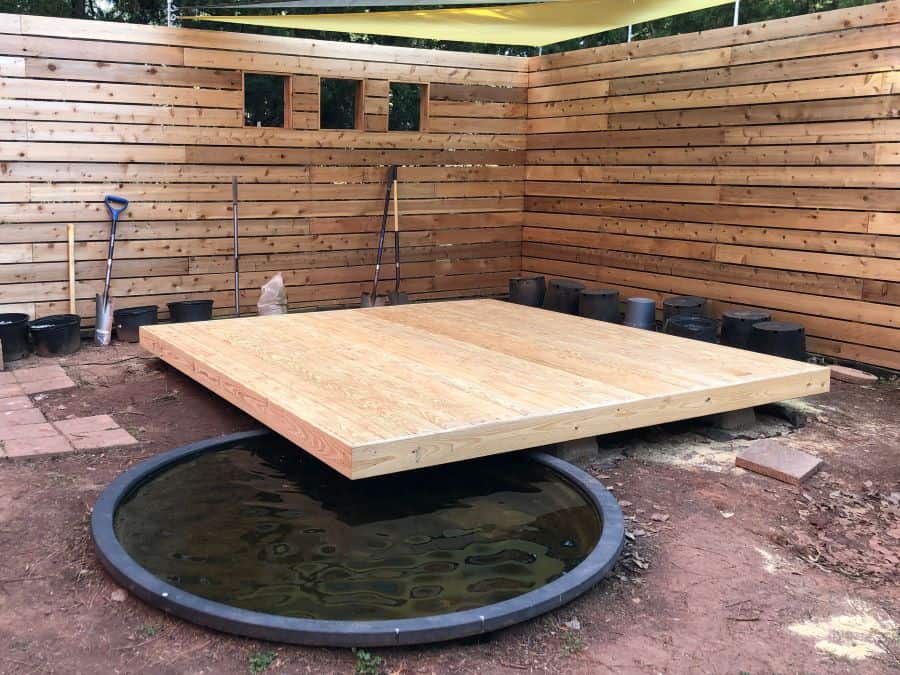
Step 12. Staining and/or Sealing Your Floating Deck
Wood is a porous material that soaks up water if not sealed properly. Rain, dew, and snow can cause untreated wood to split or crack.
However, pressure-treated wood needs to dry before it can be stained or sealed. This may take several months. Your deck is ready to seal when water absorbs quickly into the wood instead of beading up on the surface.
Apply a deck sealer to protect your floating deck from the elements. If you choose to stain the deck, select a stain with a built-in sealer. Or, apply a sealant after the stain has dried.
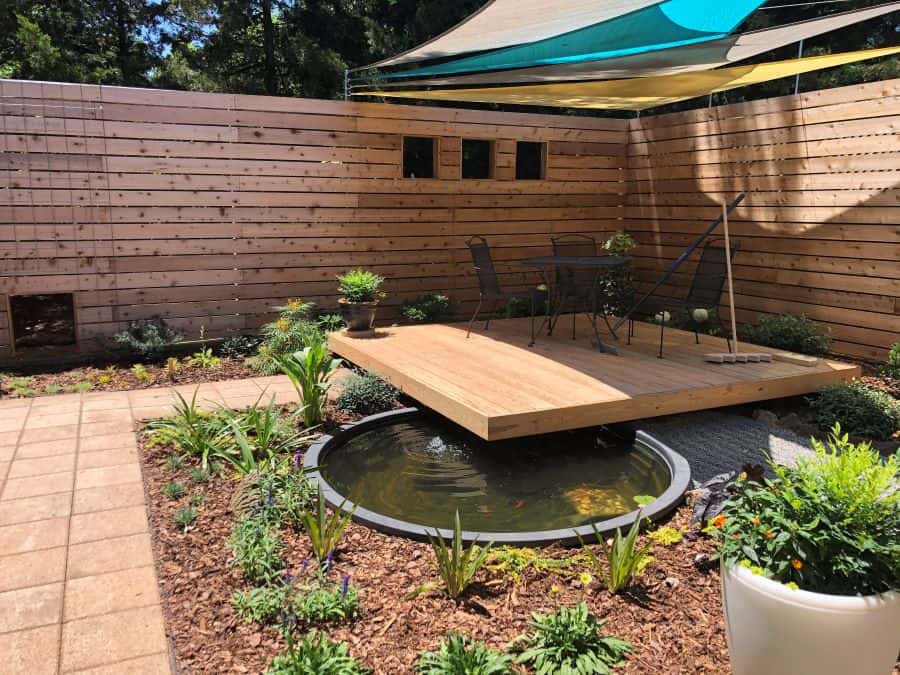
Relax and Enjoy Your Floating Deck
Finish your floating deck by styling it with furniture, plants, and accessories. Our small deck is perfectly sized for a pair of Adirondack chairs or a small patio table and chairs set. Seating areas in sunny spaces might benefit from a patio umbrella or a shade sail.
Create a visual connection between the landscape and your floating deck by repeating plants from your garden in decorative patio pots.
Now pour yourself a tall glass of lavender lemonade, relax, and enjoy the garden.


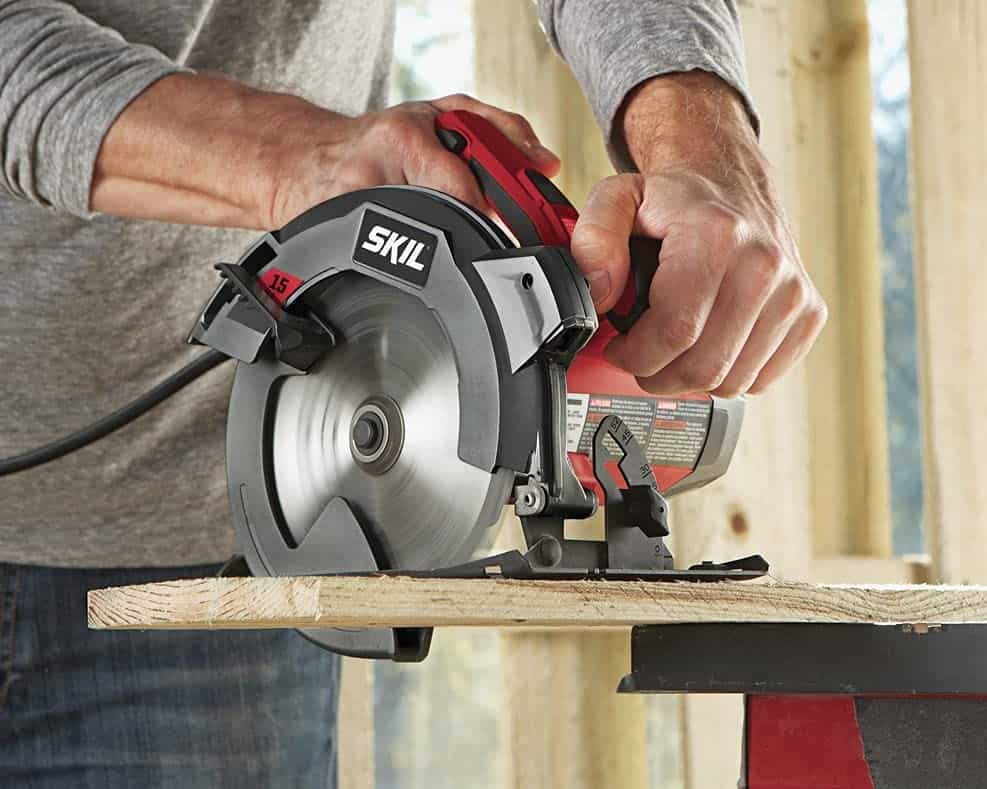


Leave a Reply